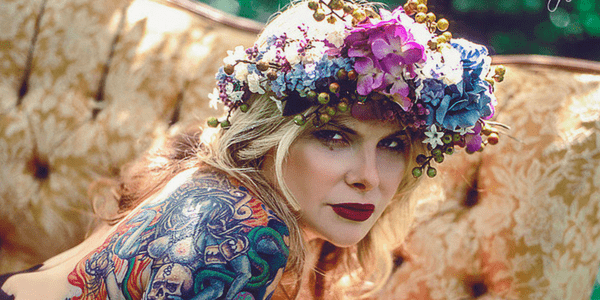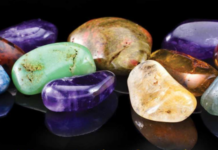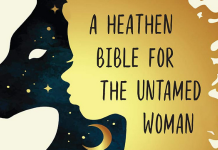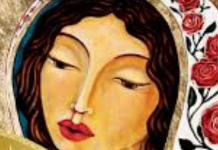
When I first walked into Danielle Dulsky’s yoga studio for Wolf-Woman Autumn Camp, I knew I was in for some serious magick. The studio was welcoming and inclusive, with women from all over the country joined together for a day of connecting with the Dark Goddess.
We began the day with a sacred cocoa ceremony to invoke Kali. This was followed by a moving meditation with yoga to channel the fury of Lilith, and the day concluded with Danielle leading us through past-life regressions, which to this day have held a marked impact on my psyche. Since that first time, I have continued to make the journey to Danielle’s studio to take part in well-crafted rituals that provide a window into my own divine nature, as well as meet an eclectic group of women with which to share the journey.
Danielle strives to help women be fearless creators of their own sacred work by being an activist for the wild woman within all of us. As a witch and yoga practitionerwoman, she blends alchemy, movement, and sisterhood to reclaim the power of women’s spirituality. Most recently, Danielle has released her first book Woman Most Wild: Three Keys to Liberating the Witch Within. I had the pleasure of speaking with her about her writing process, her thoughts on witchcraft, and her own personal magical practices.
Alanna Wright: So your new book, Woman Most Wild: Three Keys to Liberating the Witch Within is finally published and released. Congratulations! Where did your inspiration for the book come from?
Danielle Dulsky: I don’t know where you want me to start, so let’s start at the beginning. I was raised Evangelical Christian. I went to born-again Christian school and church twice a week, so I have a lot of wounds around that, with the divine being presented as external and also male. I got into yoga mostly because my mother told me it was about the devil and that interested me. But after the first class I heard the phrase “the divine in me honours the divine in you,” and that was what had been missing in my spiritual life. Yoga was really my bridge between Christianity and witchcraft. And then it was really learning on my own, reading all the books, meeting with whatever witch shop owner would talk to me. I would run out after school to talk to the freaks and the punk rockers and the witches — these are my people!
I moved to Ireland when I was 18, and had a really mystical experience which I can never explain, but I will try. I lived in Dublin and travelled west, and this experience of going off alone would usually make me panic, because I was alone in a foreign county. But I didn’t feel that way, and I just had this feeling of having been there before. A past life memory. I didn’t call it then, but that is what it was. And a feeling of being held, that someone was watching me and it was okay, and that was a new experience. So I took that home with me, and fell into a relationship, and moved to Florida and lived in a very conservative part of it. I was getting really into the craft, casting spells, but still very solitary and not telling anyone because witchcraft was still very stigmatized — even in me. I felt very wrong doing it, and it was spiritual battle.
When I was 25 — this is the huge moment — holding my son in the dark night of the soul, just feeling like I want this baby of mine to grow up as authentic as possible. I don’t want him to hide any part of who he is. How can I not be hypocritical and not hide this part of me? So I started not hiding my tarot cards or my crystal wands, and saying that I can’t do things on this day because it’s a holy day. This was my big coming out.
So what happened — which happens to a lot of women when you’re new to the craft, even though it’s supposed to be a feminist tradition — you’re still looking for someone to tell you that you’re being a good girl and doing it right. I fell into this coven that was bad news, because it was the only one around me. I think this is a common experience, that women just look for this author to tell them that they are doing it right, even when they are in a tradition that is not supposed to be that way. That is what happened to me, where the mentor was a really bad person, in a predatory way, and it took me a long time to realize that. Within a year, my spiritual community and marriage fell apart because of this predatory relationship. I moved back to Pennsylvania and decided that I was going to be solitary and never tell people I was a witch again. But that lasted five minutes, because I found community by leading yoga teacher training and a women’s circle.
The book came out of leading these women’s circles and having them do things that are, for all intents and purposes, witchcraft, and hearing them describe a sense of homecoming. There was a feeling of “I know how to do this” when they would hold the wand or call the quarters. There was an underlying theme of “I like this new thing that is my wild womanhood, (or whatever call it, usually not witchcraft) now what do I do with it?”
The book was a response to “I know how to do this, but I want more.” I wrote a step-by-step guide for someone that defies all practicalities. That was my idea for the book. It’s kind of like a strategic answer for something that doesn’t have any strategy, so what I try to do in the book is give permission for the woman to create her own craft and be authentic, rather than a spell book which gives external authority. The book is about empowerment and how to really affirm the wildness that we have oppressed since childhood because we didn’t want to be abandoned.
I, too, have heard many stories of women new to the craft who then turn away because they get mixed up with people who don’t have their best interest at heart. How can women attempt to avoid this happening?
That is such a common story. I hear that all the time. I travelled to all these different places — the story is the same no matter where you go. It’s almost always women, not so much in UK because they don’t have the rage against religion that women in the States have. But it is a common experience where, when you’re new to the craft, particularly as a woman, it seems like there is this need to be told that you are doing it right, and this immediate search for a mentor.
That usually ends up going badly, and I think that is because in witchcraft, you really have to be able to stand on your own two feet before you look for a mentor. You really don’t know enough on your own until you know how you embody the craft. Looking at your own unique rhythms and what you have always loved doing — maybe you’re creative and enjoy writing, so your spell craft will have a lot of that. Maybe you’re a dancer, so you raise energy like that. It’s looking at these talents you have and integrating them into your craft, because that is where the power comes from. And there has to be an in-the-bones belief that you have the right to affect change in the world, or the spell won’t mean anything.
For women who are coming from being very disempowered spiritually, that is huge to overcome — building self-empowerment and self-efficacy to make our spell craft that much more effective. The key is to really look for the moments you felt authentically you, and put that into your craft. Shape your craft to fit you rather than trying to fit yourself into whatever witch box you have built for yourself.
I absolutely love your style of writing and the imagery that it invokes, it is so primal and raw — unafraid to go where many would fear. When would you say you discovered your writing “voice?”
I have always written. For me, if I go back and look at those moments, I felt the most “me.” I remember writing stories in the woods, in the mountains, and being really young. Being really into these stories of little girls like me, and writing them in nature. I really think there is something inborn in the practice of feeling connected to nature when writing.
It’s been a little tough, because when you write academically, it’s about making sure everything is spelled right and that it’s really a word, but I am also writing to really surrender and allow what I feel is a very primal and divine voice to come through me. There are times when I feel like the words aren’t really coming from me, and if they are they are coming from such a deep, deep place that it feels like it’s not me.
With how powerful your words are, what do you feel you are tapping into when you are writing? A deep place within you, the collective divine feminine, channeling the voice of the Goddess?
I wouldn’t call it the voice of the Goddess. The way I define the primal feminine is a metaphor for living feminine.
As far as the integrated feminine goes, I am always after the parts of the feminine that have been socially and historically repressed. Maybe I start out with an intention that is more left-brain, but then it does feel like I can kind of tap into this primal, feminine, subconscious underground that is really fertile. Maybe it is collective, those archetypes that are kind of in the dark, but it does feel like digging. I can definitely say that. I can go to the computer and start to write and it feels like “this isn’t that great”, and I am sensitive to that because I know it’s part of the process — pages and pages written this way — and then I’ll get into a groove, and that’s when I go for hours where it just feels really organic, like it’s pouring out. And then I go back to make sure I spelled things correctly, but when I am in it, I am not really worried about that.

Can you tell me a little bit about your experience using ritual and ceremony in your practice? To this date, I have yet to experience a more powerful ritual than the ones hosted by you which I have attended. Some of my most powerful transformations have come from attending your rituals. How have you learned to hold such deeply transformative space? What goes into planning a ritual?

My philosophy on leading women’s circles is that if you’re the space holder, it’s different than being a therapist. You have to be in the space. You might break down, but you are not removed from it. Being in circles, and women being heard in way that they often aren’t in society, and the breakthroughs and breakdowns that happen in that space, were a very powerful awakening for me in terms of leading sacred work.
I remember leading many circles where there was such a strong change agency on a social and global level. It is so different, what happens in the space of a women’s circle rather than in other spaces like workshops. But there were many mistakes, like learning how far I want to go, where the edge is, and not being too scared of that. All of this is something I had to learn very slowly.
Ten years ago, I would have never have brought up the sacred wound or the dark night of the soul, which are really powerful. I would have been too scared to talk about it, so it was a slow learning experience of how to hold space firmly but still be in that space. How to break down crying but then step back in and still hold the space.
The element with the magick was kind of an organic progression. The ritual and the magick came from me wanting to bridge what happens in the magick circle of a coven, because when you take that authentic feminine voice in women’s circles, and you can unite that with circle craft, that is where the real transformation happens — when a bunch of women get together and they are working their magick together.
I just had a powerful experience at NY Wild Women Festival. It was probably the largest circle I have lead, with close to 100 women. One woman stands up and says what she wants for the autumn season, and it didn’t matter what she said but she had 99 other women looking at her and wanting that for her in her life. To have the woman stand up, and have all the other women sending her all the magick they have to make that happen — this is a really transformative experience. It is a really globally transformative experience when you see women come together and work their magick.
In terms of circle craft, the key is having your voice heard, and your desires affirmed by everyone there, so you are putting your magick alongside the mundane. You can talk about everyday things together before circle, and then go right into witchcraft. Your magick is also the conversation you’re having with the world. Whenever you cast a spell, it is saying “This is the kind of world I want to live in, that I want the people of this circle to live in, that I want the future generation of children to live in.” There are all these layers of power. In my rituals, that’s what I really try to evoke — it’s not just isolated desire for you, it’s also a conversation with the circle, and a conversation with the world. But all of that was a very slow learning process.
Your book, while promoting the authenticity and solidarity of self, really dives into the power of community to aid one’s own ultimately solitary journey. I enjoy the collaborative lens through which you have framed this journey. What do you feel community contributions to one’s sacred path is so important?
In a circle, you have the ability to have your craft affirmed. You don’t have that anywhere else. It sounds a little but fluffy to say that.
Right now it’s autumn in the northern hemisphere, so our magick is all about the dark primal feminine and there’s nothing more socially suppressed than that. That is really where patriarchy sourced its power — by suppressing magick and intuition — and to be in a circle and be able to talk about that is everything. I think a lot of collective feminine grief that goes on is because we don’t have that space anymore. If we had that circle of support, where we can be held and talk about what we are going through, that would be really powerful.
Community is really the most important piece, after you have learned to stand on your own two feet and you’ve explored your magick and your ritual in your own way. Being a part of a community is everything — even if that community meets only once a year. Having a circle where you can put magick alongside the mundane and be held is absolutely everything.
What do you think about the rise of online communities? Do you feel there is a different between connecting online and having an in-person community?
I look at social media as a really powerful feminine force. It is a tool of the mother archetype, creating all these connections and accelerating things in a way that nothing has before. As far as connection and community goes, it has been amazing. There’s this app called Divine Feminine, and all you do is put in a zip code and all these women’s circles come up. Women who haven’t been able to find community for years now can. An app for women’s circles? We didn’t have that 10 years ago!
Social media has really been an amazing tool, because we can really get together and rally against oppression to create the change we want. The day of doing that on your own, in your small circle, are over. It’s like “Lets really make this a collective movement, because witches really do hold a lot of power, which is why we have been shamed and burned and hunted. If we can get together and yoke that power in a global way, then the instruments of oppression don’t stand a chance.”
Sometimes it seems like in circle, the focus on magick outweighs the reverence for the Earth as part of the foundation of witchcraft. How do you think deep reverence for the Earth comes through in the way you live your life? In what ways do you cultivate your connection to nature?
I live in a relatively built-up area, so I have to drive to find real nature and I do that. Whenever I need a muse for my writing or magick, I go to a place where I can really immerse myself. I really have felt a layer of connection to the Earth in circle, and I think this is the reason the connections to others and what you want for the future are enhanced. For me, the real bridge between magick and the natural world is working with the rhythms of nature. It wouldn’t feel right for me, as the wheel turns to autumn, to do a hedonistic Beltane ritual. Just like in May or June, I wouldn’t do past life regression or womb work. Even if you can’t be completely immersed in nature when you work your craft, you still have the seasons and lunar cycles to inform your magick.
As far as environmental magick goes, that is so five minutes ago. Now, more and more witches are really getting together to speak out against the denigration of the Earth. We don’t want to denigrate the earth, just like don’t want to denigrate our body or soul. As witches get more into their craft and realize they want to help combat oppression, then they get more into working magick for the Earth, and community is a big part of that.
You also have your own yoga studio. How do you incorporate your bodywork into your magical practices? How does body movement connect to witchcraft and the empowerment of the feminine?
For me, I had been to a lot of rituals in my coven, and Pagan festivals as yoga practitioner, and really not seen the body being valued as an instrument for energy raising and something to be worshipped. I wasn’t seeing that, so I bridged the gap in my craft — the body is feminine, the emotions are feminine, so being able to infuse all of that into the craft in a way that feels empowering is feminine. There are people into sex magick, but that often comes off as disempowering to the feminine. If you can dance to raise energy, or move in such a way that you raise energy (because any spell is about intention and energy raising), then you direct that energy raised to the intention.
You can absolutely do energy building through movement and body prayer. Its something I teach, and I am almost always raising energy through movement. In Vinyasa yoga there is a thing called Kriya, which is repetitive movement with purpose. I started using these for energy raising, and it seemed like a really obvious link between yoga and witchcraft. I now teach people to design their own, because it is something that has to feel really authentic as far as movement and alchemy go.
What is one of your favourite daily magical routines?
Well, that’s the body prayer. The one thing that I do daily is the body prayer. I usually have a dedicated space where I can be on my mat, and I try to have an intention like I would for a spell. You know, you take yoga class and they tell you to set your intention, but I do it in a different way where it’s more of a spell. Sometimes its personal, inner circle, community, or global, but I have an intention and I have whatever I am doing as a spell. I am moving to raise energy, and then I send that energy to a particular intention. And I cast a circle first. I might write, but the common daily thread is movement and intention.
Images courtesy of Danielle Dulsky








